Have you seen a truck weighing bridge ? Do you know how it works ?
It weighs the empty weight of the truck and then the loaded weight. The difference is the weight of the cargo on that truck.
Well draft survey uses a similar principle to measure the cargo loaded on board ships.
With draft survey we measures the initial weight (displacement) of the ship and it measures the final weight (displacement) of the ship after loading. The difference plus all the weights that were taken out (like ballast) will be the cargo loaded.
The only difference between weight measurement in case of truck and ship is that for later the calculation is not that simple.
So in this post I will discuss about how to go about measuring the cargo quantity with draft survey.
1. Why Draft survey ?
On tankers, the measurement of cargo quantity loaded is simple. We know the density of the cargo and we know the volume. It is easier to know the weight of the cargo loaded.
But with cargoes like coal, we cannot measure the weight by just measuring the the height of the hold to which cargo is loaded.
This is because unlike liquids, solid cargoes would not take the shape of the hold.
Calculating the cargo loaded with draft survey is the most appropriate way.
But it isn’t only with solid cargoes. Sometimes we have to measure the cargo quantity of liquids by draft survey. One such cargo is Mollasses loaded on chemical tankers.
This cargo has air in it and thus the density of this cargo is not uniform. Calculating the way we calculate the weights for other liquids will give wrong quantity. Draft survey is the answer in this case too.
So let us see how we need to go about draft survey.
2. Basics of Draft survey
With draft survey calculations, all we want to know is the difference in ship’s arrival weight (Displacement) and departure weight (displacement).
Let us say we have these figures
On Arrival
Displacement: 20000 T
Cargo: 0
Ballast: 6000 T
Other weights : 1000 T
On Departure
Displacement: 50000 T
Cargo: ???
Ballast: 500 T
Other weights : 1000 T
The difference in displacement is 30000 T. Out of this 5500 T of ballast was removed and some cargo was loaded at the port.
It is simple calculation to know the quantity of the cargo loaded which is 35500 T.
In this simple calculation, it is not difficult to know the ballast and fuel on board. What we need to know is the displacement of the ship on arrival and after completion of loading.
Once we know that, we can know the cargo quantity. The easiest way to calculate the ship’s displacement is by noting down the draft of the vessel and looking for the displacement for that draft in the trim and stability booklet.
That is the simplest way of saying it but then there are few corrections to this which we will discuss.
3. Draft of the vessel
There are two drafts for a vessel.
- Draft at forward and aft perpendiculars and at midship of these two. This is the draft that is listed in the ship’s trim and stability booklet.
- Drafts at actual draft marks painted on ship side.
So to get the displacement from the trim and stability booklet, we must get the drafts at the perpendiculars.
What we will get from the visual drafts will not be the drafts at perpendiculars in most of the cases.
Let us say we have the visual draft as follows. In draft survey calculation we call the visual drafts as “Apparent drafts”.
So let us say that the mean of both side of the apparent drafts is
Forward = 6.43 m
Aft = 8.53 m
Midship = 7.42 m
Apparent Trim = 2.1 m
As I said we need to bring these drafts to the perpendiculars.
The formula for correction to the visuals drafts to bring it to the perpendiculars is
You will find this distances in the Trim and stability book of the ship. Have a look at these corrections for one of the ship.
As we can see that the distance from forward perpendicular to the forward draft mark is 9.95 meters.
So the correction to the forward draft would be 9.95 x 2.10 / 155. This will be equal to 0.135 meters. As the forward perpendiculr is forward of the draft marks and we have stern trim, this correction will be negative.
Same way for apparent trim of 2.10 meters, the corrections to the apparent drafts are
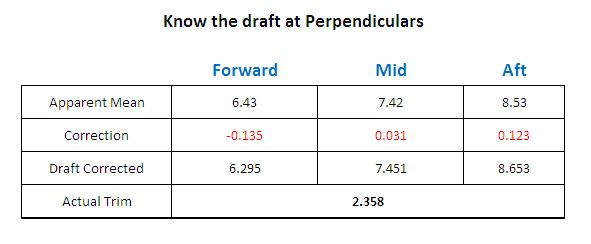
So the drafts at forward and aft perpendiculars and midship will be 6.295 m / 8.653 m / 7.451 m respectively.
Ideally we should now take the midship draft (7.451 m in this case) and look for the displacement from the trim and stability booklet.
But there can be errors in this drafts and we have to make sure that draft is correct. These error could be
- Errors in reading few of the visual drafts
- Errors due to Hog or Sag of the vessel
To minimise these errors we finalise the draft of the vessel by having mean of means draft. This is also called Quarter mean draft.

Mean of means is considered to be the accurate draft of the vessel at the midship. This is the draft we need to enter in the trim and stability booklet.
Below is the mean of means draft for our example.
4. Calculating displacement of the ship
Now that we know the draft of the ship, we can open the trim and stability booklet and check the displacement for this draft.
We may have to interpolate to get the exact displacement.
Here is the relevant page of Trim and stability booklet for this ship.
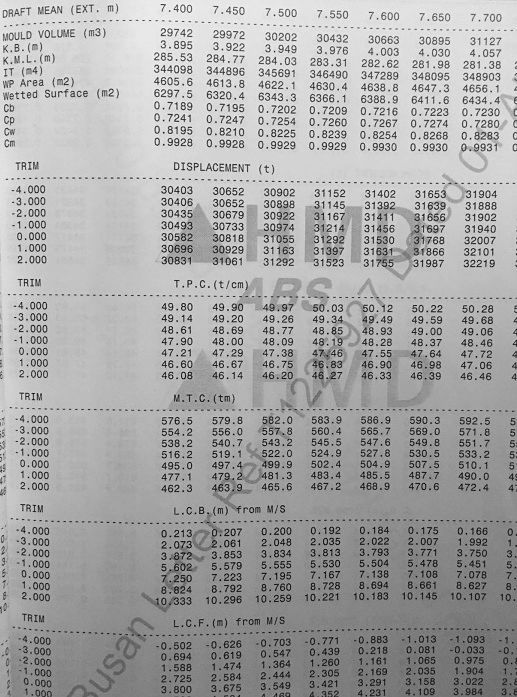 So the displacement for our draft of 7.45675 m will be 30702.28.
So the displacement for our draft of 7.45675 m will be 30702.28.
We have now got the displacement for the actual draft of th vessel. But there will be few corrections to this displacement. Let us see what these are.
5. 1st Trim correction
The draft and displacement we got so far is at the mean of aft and forward perpendicular.
As per Archimedes principle, a floating ship displaces the amount of water equal to its own weight. And the ship floats at the center of floatation. So the correct displacement is the displacement corresponding to the draft at the center of floatation and not at the mean draft.
The correction applied to the displacement at mean draft to bring it to the displacement at center of floatation is called the “1st Trim correction”.
The formula for 1st trim correction is
If you wish to know how this formula arrived, watch this video
As we need the values of TPC and LCF for calculating 1st trim correction, open the Trim & stability booklet and find these values for the vessel’s draft. Again we have to do the interpolation to get the exact values.
Now let us calculate the 1st Trim correction for our example.
In this case it comes out to be 65 T but it can have larger value in other situations. This 1st trim correction we need to add to the displacement we got earlier.
Sign of 1st trim correction
This is not so difficult to find. We have the draft at the Midship and we are applying the correction for change in draft because LCF is not at the midship.
Now let us say vessel has stern trim and LCF is aft of midship. Which draft will be more ? The one read at the LCG or at the midship ?
You are right !!! The draft at the LCF will be more. So in this case the correction need to be added to the midship displacement we have got.
So for sign of 1st trim correction, all we have to see is the location of LCF with respect to Midship.
So for sign of 1st trim correction, all we have to see is the location of LCF with respect to Midship. Then by pure logic, we can find out if we need to add that correction or subtract.
6. 2nd Trim correction
Now there is this another correction. First trim correction was because LCF was not at the midship. If the LCF was at the midship, there would not be any 1st trim correction.
The distance of LCF from the midship is given in the trim and stability booklet. For hydrostatic ship particulars for some ships, the value of LCF is at zero trim condition. For example see below
Now if the vessel is trimmed, the position of LCF will change slightly because of change in water plane of the ship.
2nd Trim correction takes care of this change of position of LCF because of trim of the vessel.
The formula for 2nd trim correction is
To get the value of Dm-Dz, get the value of MCTC for (mean draft +50 cms) and for (mean draft-50 cms). The difference between these two values of MCTC will be the value for Dm-Dz.
With this value of Dm-Dz, we will get 2nd Trim correction as 35 T.
The 2nd trim correction is always positive.
But see the hydrosatic particulars of the vessel that I took the data from. LCF values are given for different trims.
We can interpolate to get the LCF for actual trim of the vessel. In this case 2nd trim correction will not be applicable.
7. Final Displacement
Once we have 1st trim correction and 2nd trim correction, we need to apply these to the ship’s displacement.
So the actual displacement with respect to the draft at LCF will be
Displacement at Midship + 1st Trim correction + 2nd Trim correction
In our example this would be 30702.28 + 65 +0 = 30802.28 T
8. Density correction
We have now got the displacement for quarter mean draft. To this displacement we have applied 1st trim correction and 2nd trim correction.
We now have vessel’s actual displacement. But this displacement is in salt water density of 1.025 as most of the hydrostatic tables have the data for that density.
Now if the water density around the vessel is different than 1.025, the displacement of the vessel will change.
Why ? As per archimedes principle the ship displaces water equal to its own weight. If the density of the water is more, ship would displace less volume of water (less draft). And if density of the water is lesser, it would need to displace more volume of water (more draft) to have same weight as of the ship itself.
For draft survey, we need to measure the density of dock water just before or after reading the visual drafts. The density is measured by draft survey hydrometer with a sample of dock water drawn from around the vessel.
The density of dock water changes with depth. So it is important to know at what depth the sample is drawn. Many take the sample from a depth that is half the draft of the vessel. Others prefer to take the sample by running the emergency fire pump.
Now say we have measured the density and we have the dock water density as 1.01
So how to correct the displacement we calculated so far for density ?
So in our example it will be 30802.28 x 1.01/1.025. That will be equal to 30351.51.
9. Cargo quantity from initial and final displacement
Apart from calculating the displacement, we need to to know the existing weights on vessel.
For example we need to know the exact weight of ballast, Fuel oil, Lube oil, fresh water etc on board on arrival. That is not a difficult thing to know. But there are some best practices.
First it is easier to measure the quantity if a tank is either completely full or completely empty. This also removes the ambiguity and measurement error.
Second, the vessel must not be down by head (negative trim). This is because it brings ambiguity to the actual quantity of ballast in a tank.
Third, since we need to know the weight of the ballast, we must know the density of the water in the ballast. We will know the volume from the sounding table and multiplying with the density will give the weight in each ballast tank.
Fourth, we need to measure and sound each space on ship and not assume that it is empty. For example if there is any void spaces, we must sound these spaces as well.
So now we will know what contributes to the the arrival displacement of the ship.
Arrival displacement = Lightweight of ship + Ballast + Fuel + Fresh water + Lube oil + Constants
And among these things we know the quantity of ballast, fuel, lube oil, and fresh water.
We need to repeat this calculation and measurement of all spaces after completion of loading.
Departure Displacement = Cargo + Lightweight of ship + Ballast + Fuel + Fresh water + Lube oil + Constants
Lightweight of the ship and constants will remain same and so these does not matter. We would know the arrival and departure displacement from draft survey. All other weights we know by sounding and measurement. The only known is the cargo loaded. It is simple mathematics then to know the cargo quantity.
10. Calculating constants on arrival
Calculating constants is not really required if our aim is only to know the weight of the cargo loaded. This is because the the quantity of constants will not change.
But calculating the constants on arrival is a good practice. This gives a fair idea of the correctness of calculation. For example, let us say we know that constants will be in the range of 200 to 300 tons.
If initial calculations give too high or too low constants, we know something is wrong somewhere.
We can sometimes get negative constants. This would mean that we have done some mistake and we must find it and correct it. It may be that we have wrong drafts, wrong soundings etc. Whatever it is, we must correct it before loading starts.
Conclusion
Draft survey is widely used for cargo measurement. It is acceptable way of measuring the cargo quantity.
The calculation however requires practice. It may sometimes be confusing to seafarers using the draft survey for the first time. This can lead to the errors in calculations and cargo claims.
We must know the basics of the draft survey. Once we know that draft survey would not look that difficult.
Share this:

About Capt Rajeev Jassal
Capt. Rajeev Jassal has sailed for over 24 years mainly on crude oil, product and chemical tankers. He holds MBA in shipping & Logistics degree from London. He has done extensive research on quantitatively measuring Safety culture onboard and safety climate ashore which he believes is the most important element for safer shipping.
Search Blog
96 Comments


ffff

Fantastic blog post! I love your website, excellent information.

Glad to hear that John...

Hi Rajeev, Brillaint article. Was just wondering if the above applies to the below problem: A transport barge is 130 metres long and floats at draughts of 6.0 m forward and 6.5 m aft. It is to load a steel casting of 250 tonnes in a position on deck which is 80 m from the aft perpendicular. The barge has the following hydrostatic data:- MCTC = 125 TPC = 25t Centre of floatation is amidships. Calculate the final draughts after completion of loading. Will appreciate your assistance.

Hi Rajeev / Rohan, how did you go with this calculation? I'm interested in this outcome?

Hi Sir, Many thanks for your presentation its really help me in the area of draft survey.

Dear Capt. Rajeev Jassal! Thank You for this post! I just want to ask one more question. What to do, if we have thickness of keel plate in our calculations. For example, thickness of keel plate is 22mm. Base line is line above keel plate. Should we substact this value when calculating true draft at perprndiculars or when calculating Mean of Means? Or we shoud add this value? Thank You!

Look on www.draftsurvey.org download software and create new ship, there is a nice help where is perfectly explained how is it with keel thickness correction. Generally this correction is used to match two drafts: read drafts from draft marks and hydrostatic table drafts column. Usually draft marks has datum welded on the bottom line of keel plate. So once you calculate MMM draft you have a draft from 'bottom edge' of keel. Now you open your hydros. table booklet and you like to read displacement. There is a column with drafts from e.g. 2.50 to 15.00 m, these drafts could be from bottom or top edge of keel plate. This information is always included in hydrost. table. (here in Mr. Rajeev article hydros. table fragment has drafts from top of keel plate - see picture). In case that read draft is from bottom of keel plate and drafts in HT column from top of keel plate you have to subtract the keel thickness from MMM draft. In case that you will have hydros. table from bottom of keel plate you are omitting this correction.

Thanks for confirmation! I thought in the same way) And another way, in case we have drafts at perpendiculars and we need to calculate drafts at at draft marks we should add keel thickness))

how to know if the read draft is from top or bottom of the keel, thanks.

Sir, my question is: is the formula for getting apparent trim is constant: trim = aft draft - forward draft , Is that formula constant ??? Or no constant formula just apparent trim is derived from always subtracting the smaller draft into the bigger draft.... for example: aft draft = 7 m fwd draft= 5 so trim= aft - fwd = 2m or aft draft = 5 fwd draft= 7 m so trim= fwd - aft = 2m i just want to clarify this, sorry for stupid question .. thanks.

First trim correction: TRUE TRIM always minus to stern, everything running left with minus, everything running right is plus. E.g. LCF is longitudinal center of flotation, it mean distance between AP (aft perpendicular) and center of flotation (f), the value is always positive because running right from AP. The distance from midships to flotation (Xf) = (LBP / 2) - LCF, in this case when running left from midships (LCF < LBP/2) it will be minus, when right it will be plus (LCF > LBP/2). The first trim correction will be positive when, Xf is positive and Trim is positive or Xf is negative and Trim is negative, otherwise the first trim correction is positive. So remember left and right hand rule and you cannot make mistake. Same in Astronavigation what we are using is 'right' like (E) as + and on the other side 'left' (W) as minus. Do not implementing this crazy rules bigger draft and trim to bow or stern. Follow the maritime standards.

YOU ARE PRETENDING TO BE AN EXPERT YET YOU KNOW NOTHING. EVERYTHING YOU WRITE IS WRONG. PERIOD

WELL PLEASE YOU WRITE CORRECTED ARTICLE WHERE WE CAN LEARN SOMETHINGS FROM YOU TOO... IF YOU ARE ABLE TO....????

Nice article, very comprehensive. I have small remark, your logic around first trim correction is little off (results are ok, no mistakes), but the logic is off. Exactly this approach to first trim correction is making mess in students heads. Nobody properly follow Cartesian coordinate system and this is the main problem in determination of the positive and negative value of trim, LCF, Xf and finally first trim correction. If your are looking for best software, try www.draftsurvey.org

First trim correction: TRUE TRIM always minus to stern, everything running left with minus, everything running right is plus. E.g. LCF is longitudinal center of flotation, it mean distance between AP (aft perpendicular) and center of flotation (f), the value is always positive because running right from AP. The distance from midships to flotation (Xf) = (LBP / 2) - LCF, in this case when running left from midships (LCF < LBP/2) it will be minus, when right it will be plus (LCF > LBP/2). The first trim correction will be positive when, Xf is positive and Trim is positive or Xf is negative and Trim is negative, otherwise the first trim correction is positive. So remember left and right hand rule and you cannot make mistake. Same in Astronavigation what we are using is 'right' like (E) as + and on the other side 'left' (W) as minus. Do not implementing this crazy rules bigger draft and trim to bow or stern. Follow the maritime standards.

I just wonder why so many site talk about draft survey but few or almost none mention about Heeling correction and deflect ( hogging and sagging) since we accept condition of ship for draft survey should not has list more than 0.5 degree. In real situation it's can easily found 1-2 degree listing sometime.

The qtr mean draft is calculated to take care of hull deflection.As the heel correction is very small and ships do generally sail upright ,heel correction is neglected.

quatermeans does not take care off hull deflection, Quatermean is only calculated to find the draft at the point of the Xf. heel correction should not be neglected but is subject to discussion, specially then a claim or LOP is imminent it should be calculated as wel as an exact deflection calculation.

Sir if it is written in stability booklet that ,the draft is measured from the upper edge of keel..do I need to apply keel correction...Which h draft is used for draft survey ,the moulded draft ?

great, Thank you all for enriching the blog with valuable information

Tonnes of thanks!!!

I followed calculations (to check my many-years-old excel form) and got different figures for LCF and TPC as well as 2nd trim correction values. Manual re-check didn't help me. Could sb check, please?

How do you know that the second trim correction is not applicable? And when is it applicable?

Question: What will be the draft when the barge is empty? Barge details are 8000DWT(YXH- 2000), Length 122.25M, Breadth MLD 20M, Depth MLD 7.2M, Design Draft 4.8M, Scantling Draft 5.2M, Dead weight 8000DWT, Gross tonnage 6000T.

Dear Rajeev Jassal, is it all this what deck officers do routinely arriving/departing? Or it is being done just for the sake of surveillance by a surveyor? Thank you sir.

Based on my experiences, Draft survey always being done by Deck Officer together with Surveyor. . . . In this case, Deck Officer means Chief Officer, but in some cases by the Ship's Captain

I'm sorry. . . . .Yes, routinely loading/ unloading

Not all the time negative constant means something is wrong with measurements/calculations. How about: -steel stencions on log cariers removed and light ship value not updated - decks inside holds and light ship value not updated - chief engineer "forget" to declare all fuel on board - lifting devices removed during vesèls life time and again forget about the light ship value to be updated - vessel previously run aground or with bad reconstruction - vessels showing big hogging from other various reasons I'm not saying not to check again, but sometimes this could be the true: negative constant.

Very nice n well written article. I appreciate your good effort. We shoulf always share our knowledge.

Thanks for clear explaination, the end was difficult caus'of many calculation before that. But the work was well dealing, just thanks captain. Eugene Mavoungou. Deck officer

Hi sir RAJEEV my question is Vessel L.O.A 228.99M AND LPP 222M DRAFT FWD 7.50M AFT 8.50 MEAN DRAFT 8.00M MID DRAFT FWD DRAFT MARKING IS 4.00 FROM FWD PERPENDICULAR AND AFT DRAFT IS 9.85M FROM AFT PERPENDICULAR APPLY THE TRIM CORRECTION OF YOUR APPARENT DRAFT FIND THE QUARTER MEAN DRAFT

Nicely Explained.

here is my question......... the plan area of a figure is 207.13m... find the volume of astern with hight of 1.25.....

Assalamu alaikum.Dear Sir,How do i understand + or - 1st trim correction?When time 1st trim positive or negative i don't konw?please sir,Known to me?

Fine and wonder full.

Please tell me, if the barge list to Starboard 2 deg. with barge breadth 24 m. Port side draft is 5m. how to cal. the starboard draft ? Thanks

Capt. I am an avid fan of you, but for this topic I just want to know how do you come up with the figures for interpolation of LCF and TPC because it doesn't coincide with my computation, e.g. the given figures for LCF of 7.45 and 7.5 drafts were 1.0465 and 0.9555 respectively. My computation goes like this, I would subtract 1.0465 and 0.9555 so I would have 0.091 then divide this for 5000 units, therefore giving me 0.0000182 for each unit. I will multiply the later to 675 so I would have 0.012285. Subtract this from 1.0465 so I came up with the answer for interpolation of 7.45675 to 1.034215, which is quite too far from your given answer (0.9851).

Thanks Sir, very nicely expalined.

thanks for Nicely Explained

sir how can i get the port side draft if the manometer reading is list to portside is 10cm, startboard draft F=8.2 A=10.5 M=9.35. thanks

Nice

Hi Cpt Basic draft survey was well expl. I would like to now how can i apply ballast correction when i dont have ballast correction book . Thnx

Happy New Year! We specialized in Bank Guarantee {BG}, Standby Letter of Credit {SBLC}, Medium Term Notes {MTN}, Confirmable Bank Draft {CBD} as well as other financial instruments issued from AAA Rated bank such as HSBC Bank Hong Kong, HSBC Bank London, Deutsche Bank AG Frankfurt, Barclays Bank , Standard Chartered Bank and others on lease at the lowest available rates depending on the face value of the instrument needed. We will be glad to share our working procedures with you upon request to help us proceed towards closing deals effectively. Email: jpettyinstrumentlender01@gmail.com Skype: jpettyinstrumentlender01 Regards James Petty

Thank you very much.that is good explanation.

Very nice. Well explained

The 2nd trim correction must be demonstrated for peaple using draft survey . Draft survey is accepted within only small trim about LBP/100 max . This means the Change in weight from evenkeel to very small trim . Ex : trim 3 m gives 2nd correction 9 times as much compared to trim : 1m in the same condition .

I need an address of a school (institute) that provides training on the draft survey in French-speaking countries in Europe thanks in advance.

sir why 2nd trim correction is always positive

Sir, If you add the loadicator method too , It will be more complete guide. Plus , I want to know , what will be the correct weight of ballast , since the density of ballast water varies from which time it is taken and from which place it is taken from. And Also , Now , The BWMP also makes mandatory for exchange of Ballast water which makes it more complicated.

Hello, very informative article. However, does anyone know where to find Draft survey programs?

Sir, I have got the draft of port side and vessel is listed 1 degree towards starboard side. Then how to calculate the draft of starboard side.

0.01746 x angle x shipsbeam = diff in draft Ps and Sb

Interpolation seems to me wrong can you recheck and if it has mistaken pls recorrect it because people are also calculating via your values, thanks.

This is a masterpiece and a well articulated writeup. I've read two of your great work on cargo survey- Cargo calculations with ASTM Tables and this one. How I wish you were my classroom teacher. I indeed appreciate you for sharing your knowledge with us. Please do you have more articles on cargo survey for us? Could you let us know the topics of the articles? Once again, thanks a million times.

This is a masterpiece and a well articulated writeup. I've read two of your great work on cargo survey- Cargo calculations with ASTM Tables and this one. How I wish you were my classroom teacher. I indeed appreciate you for sharing your knowledge with us. Please do you have more articles on cargo survey for us? Could you let us know the topics of the articles? Once again, thanks a million times.

This is a masterpiece and a well articulated writeup. I've read two of your great work on cargo survey- Cargo calculations with ASTM Tables and this one. How I wish you were my classroom teacher. I indeed appreciate you for sharing your knowledge with us. Please do you have more articles on cargo survey for us? Could you let us know the topics of the articles? Once again, thanks a million times.

Fantastic blog post! I love your website, excellent information

Fantastic blog post, excellent information

sir, could you please explain first trim correction equation, the one which you explained (trim(cm)x Lcf x tpc )/lbp but the video explains (hf x trim) / lbp and some other explanations are (trim x hf x tpc x 100)/lbp....which one is reliable pls explain

Thanks for providing informatin about draft survey

Iam about to 1st trim correction. According to your rule inside of green square the 1st correction must be positive if stern trim and LCF is aft of m/s. But in the calculation you present here LCF was found 0.9851, the number is positive it means LCF is located front of m/s. Why the 1st trim correction in your calculation is positive if trim to left side and LCF to right??? Thanks.

I would like to know the correct procedure to apply first trim correction....First trim correction can be applied to displacement obtained from quarter mean draft by formula (LBP/2)-LCFXTRIMX100XTPC/LBP OR by applying first trim correction by formula (LBP/2)-LCFXTRIM/LBP to get true mean draft TMD nd therefter get corresponding displacement from True mean draft TMD. Kindly clarify this doubt.

Dear Capt. Rajeev Jassal, What do you think about the new SAFETY method of Draft Survey, which will allow you to read the vessel’s Draft from the screen of your mobile phone staying on deck of the vessel? Please open – www.alexxpluss.com

Sir why we calculate ballast volume with apprent trim and not with true trim?

It seems there are 2 errors in the example above, In the first trim correction the LCF interpolation. In second trim correction the trim was not squared. Can you check?

Is there a rule or rule that excludes the obligation to calculate a ship's constant before starting a loading operation?

Dear capt. Thank you for your good post. I have one question. If ship have list and trim, Mean draft will be using when checking full load line? Or Q/M draft?

Thank you Captain for sharing your knowledge and experience. This article has further enlighten me.

where did you get this LBP equal to 174 you use to calculate the 1st trim correction thus the value of LBP is 155?

nice and clear explanation. Very useful. Thanks

My friend, good day! As I can see from section 4, you find Your displacement based on trim of 2.3 but in this case you don't need to calculate 1st and 2nd trim correction any more!!! If You still use 1st and 2nd trim correction then You should find your displacement in section for trim 0. May be I'm wrong, so I will be happy if will comment. Many thanks in advance!!!!

YES, I think so. this made the correction twice.

what I wanna say is exactly the same.

Sir, I have got the draft of port side and vessel is listed 1 degree towards starboard side. Then how to calculate the draft of starboard side.

Thank you very much.that is good explanation.

Thanks for the effort and time put in to explain each and every aspect in a very simple manner.

Please help me.. 1.what are the actions are you required to take when you found overdraft condition. 2.what action is/are important to take to minimize loss/damage after it happens. 3.in order to prevent same incident in the future what kind of training/assessment/screening for seafarer by company do you think necessary?

Thank you. I enjoy the little I glance through Please kindly send me the written paper for proper study. (I want it) Thanks again

Draft survey is wrong because in this example table of korea vessel trim corrections already included in the tables except if you take displacement at 0 trim then you need to calculate trim corrections

Thr 1st & 2nd trim correction have mathematical demonstration. NOMOTO formula requiring deep knowledge to get through I suggest that studies trial from the whole partipants to explain that 2 formulae are not random in use. Regards Miladi samir Tunisia

Dear Sir, Good Day! Thanks for draft survey to explained in very easy method. Sir I have one doubt ,in MBC surveyor came onload and he did always trim + in loading condition and in discharge condition always - ,I ask why but he not Abe to explain me. Kindly expand Sir Thanks & Best Regards Jitendra Gupta

Capt sir, thank you for creating such informative and detailed posts on your page. Apart from your page, there seems to be very little online reference regarding our profession. You are truly a godsend, sir.

Hi Rajeev Good day. Gone through all the posts, very well explained. Just one quarry? If there are no trimming tables on board, how to you calculate to achieve a required departure trim to a certain mid ship draft by using hold LCG's and Lcf method. If you know the formula, appreciate sharing it. Thanks. Vk

Hi, thank you so much for this insightful post. I do also have a suggestion for people who want to lose weight, you can try this weight loss product. It really helped me a lot to get a fit body. https://www.superproductsreview.com/get/eatstop

Nice blog.

I’ve read a few excellent stuff here. Certainly worth bookmarking for revisiting. I surprise how a lot effort you place to make this sort of excellent informative website. from satta fast

I have understood the first trim correction based on the video you have shared. but how about the derivation of 2nd trim correction? I hope that you would share also the video of 2nd trim correction. thank you.

Sir my summer draft is given 12.80 moulded and my hydrostatic particulars also have displacement for moulded draft, but my drafts on ship sides are marked from bottom of keel plate, my keel thikness is 0.018m, so when loading up to summer draft so i can load up to 12.818m visual ship side drafts..
Leave Comment
More things to do on myseatime

MySeaTime Blogs
Learn the difficult concepts of sailing described in a easy and story-telling way. These detailed and well researched articles provides value reading for all ranks.

Seafarers Question Answers
Ask or answer a question on this forum. Knowledge dies if it remains in our head. Share your knowledge by writing answers to the question

MySeaTime Podcast
This podcast on the maritime matters will provide value to the listeners. Short, crisp and full of value. Stay tuned for this section.

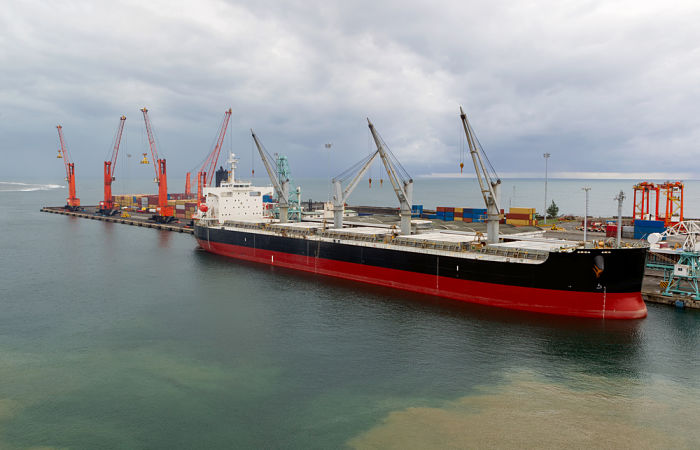
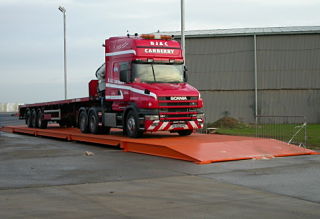
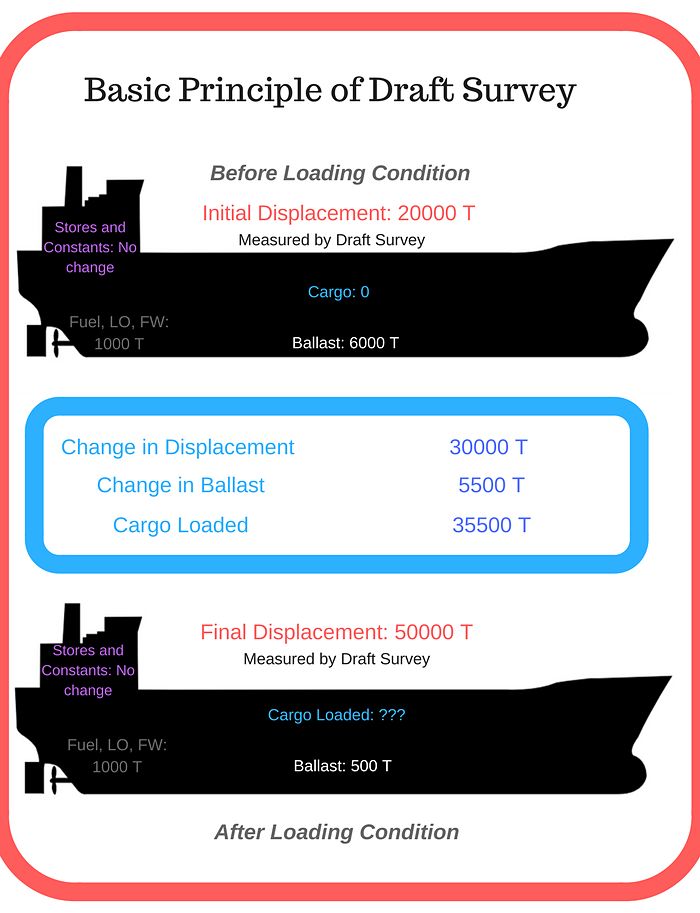
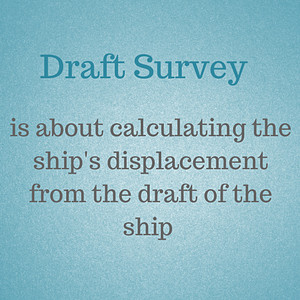

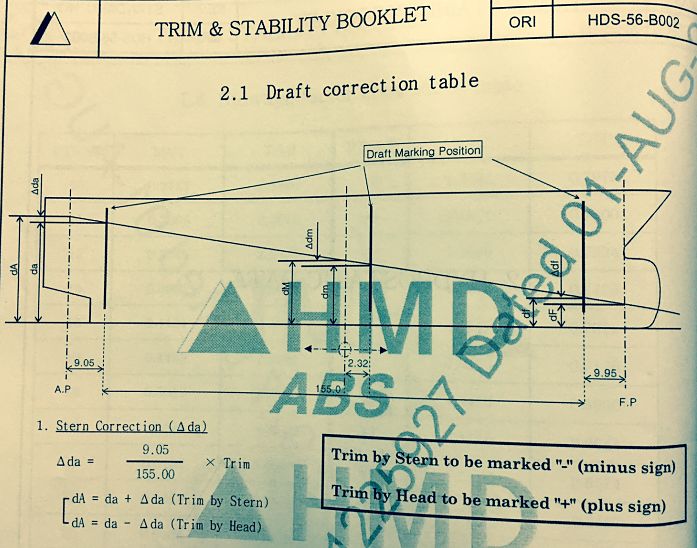
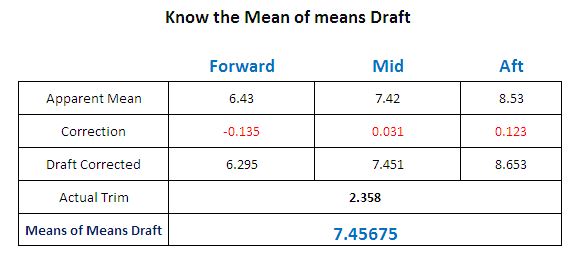
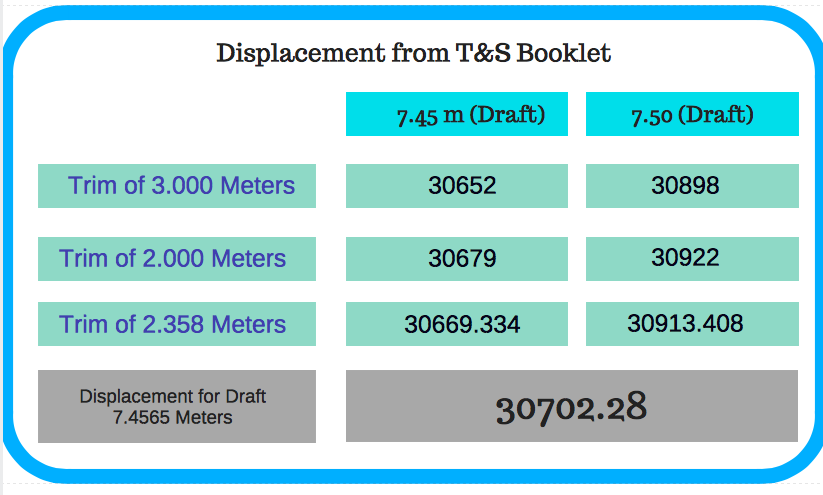



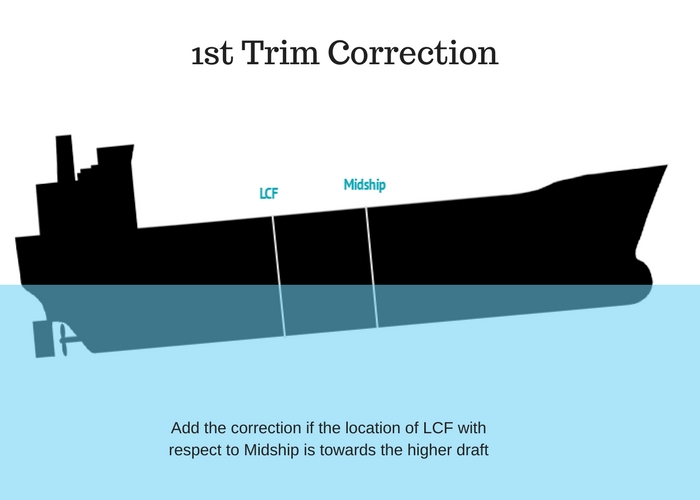
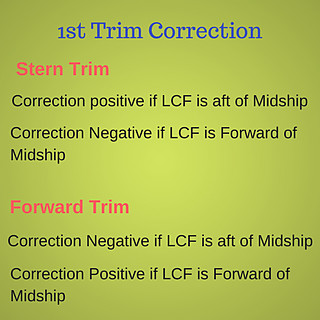
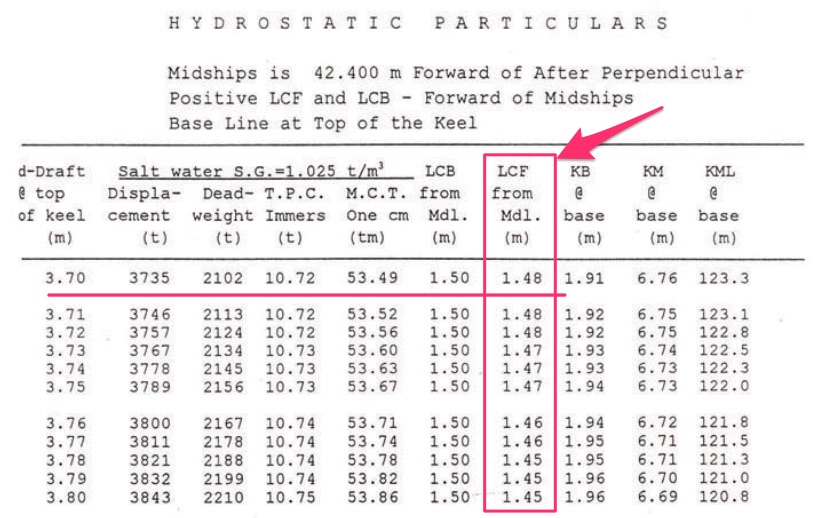

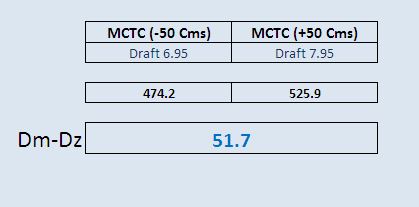
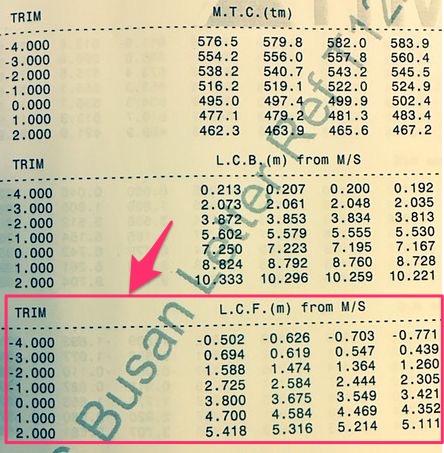
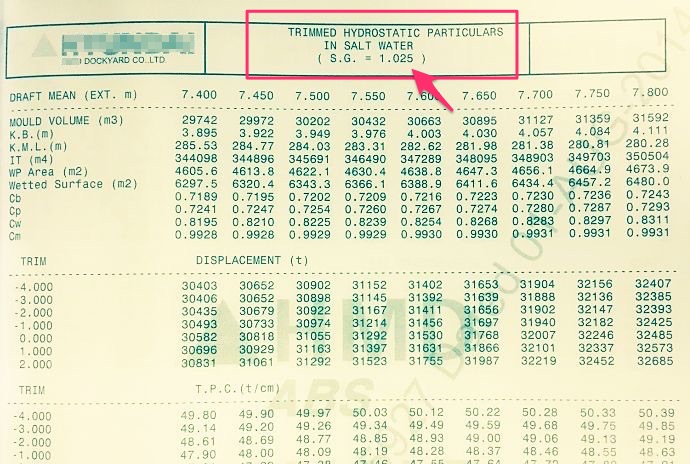

I just went thru your article on draft survey. Well depicted and explained. Good guide for people actually doing it specially Surveyor appointed to do so, as many a times they do not have perfect knowledge and may get carried away ...thanks for sharing
Thanks Sunil..
Gd day mr jassal. Its amazing blog. I just want to ask ,how you get this displacement 30702.28 ? My calculations is less. Many thanks
many thanks for your presentation its really help me in the area of draft survey.
Same here, wondering how did you get this displacement 30702,28?... regards
You might be right. Correct Disp. has to be 30701.06 mts by double linear interpolation. It is not big mistake but just small difference.
is constant should be apply in discharging port to initial and final draft survey or not?